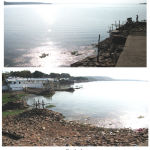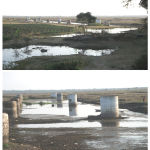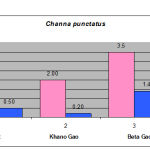Manuscript accepted on :May 08, 2011
Published online on: 28-11-2015
Plagiarism Check: Yes
Mangla Raibole¹ and Y. P. Singh²
¹Department of Zoology, Regional Institute of Education Shyamla Hills NCERT Bhopal India.
²Jawahar Lal Nehru PG College Shyamlla Hills, Bhopal - 462 003 India.
Abstract
The aim of present investigation is to assess the concentration of heavy metals (Pollutants) copper and lead in fish samples of (Channa punctatus and Wallago attu) by Atomic Absorption Spectrophotometer (AAS).The lower Concentration of copper and lead is determined about 2.0 mg/kg and 0.2 mg/kg in Channa punctatus respectively and The lower Concentration of copper and lead is determined about 2.2 mg/kg and 0.4 mg/kg in Wallago attu respectively from the site of khano gaon ,this site not contain any agriculture waste. The higher concentration of copper is about 3.5mg/kg and lead is determined 1.4mg/kg in Channa punctatus, and in Wallago attu copper is about 3.5mg/kg and lead is present 1.5mg/kg respectively the site of Beta Gaon these two sites belong to Upper Lake of Bhopal. Author determined the Upper Lake of Bhopal. The lower and higher concentration of copper and lead in Channa punctatus and Wallago attu The. high load of pollutant in Beta Gaon site which is received rural and agriculture waste it is main caused of pollution this area used by fisher man for the catching of fishes .
Keywords
Copper and lead; concentration; freshwater fish; ecosystem; consumers
Download this article as:| Copy the following to cite this article: Raibole M, Singh Y. P. Study of Cardiac Status and Lipid Profile in Young Asymptomatic Cigarette Smokers and Tobacco Chewers. Biomed Pharmacol J 2011;4(1) |
| Copy the following to cite this URL: Raibole M, Singh Y. P. Study of Cardiac Status and Lipid Profile in Young Asymptomatic Cigarette Smokers and Tobacco Chewers. Biomed Pharmacol J 2011;4(1). Available from: http://biomedpharmajournal.org/?p=1892 |
Introduction
Water pollution is the contamination of streams, lakes, underground water & oceans by substances harmful to living thing. Water is necessary to life on earth. All organisms contain it some live in it, some drink it. Plants and animals require water that moderately pure, and they cannot survive if their water is loaded with toxic chemicals or harmful microorganisms. if severe water pollution can kill large numbers of fish, birds, and other animals, in some cases killing all members of a species in an affected area. Pollution makes streams, lakes, and coastal waters unpleasant to look at, to smell, and to swim in. Fish harvested from polluted waters maybe unsafe to eat. People who ingest polluted water can become ill, and with prolonged exposure, may develop cancers or bear children with birth defects.
The Pollution of aquatic ecosystem by heavy metals is an important environmental problem. The substances causing pollution are called pollutants. Copper is about 2 ppb is fetal to fishes and Zinc, Nickel and lead about 1 ppm concentration is lethal for fishes. Heavy metals constitute some of the most hazardous substances than can bioaccumulation.
Fishes is an important and acceptable food by consumers for its nutritive value fishes are often the top most consumers in aquatic ecosystem.
Bhopal, the capital of M.P. is know as the city of Lakes. The Upper Lake is located between latitude 230 12-230 16’N and longitude 770 18-770 23’E. it is a shallow tropical Lake. Upper Lake is surrounded by residential areas, green parks, boating club and agriculture areas.
The Lake is also rich in bio – diversity Upper Lake received waste materials from the surrounding areas. Water body gets contaminated with a variety of pollutants generated form diverse sources (agricultural and domestic). Among the pollutants, pesticides, heavy metals and detergents are the major cause of concern for aquatic environment becomes of their toxicity, persistency and tendency to accumulate in organism.
Sites
There are Three Sites
Rethghat
This site is situated near Kamla park surrounded by running area, temple and mazid area, this site received the waste materials of temple and maszid. fisherman used this site to catching the fishes.
 |
Figure 1 |
Khano Gaon
This site surrounded by residential area and can not be contain any industrial effluent, this site contain only residential waste, and fisher man used to catching the fishes.
 |
Figure 2 |
Beta Gaon
The ending part of Upper Lake call to Beta Goa, it is large rural area. This site use by formers for the agriculture purpose, fisher man also used this site for catching the fishes, it received the waste material of rural area, agriculture waste (pesticides etc) from this site, collect the fishes which contain higher concentration.
 |
Figure 3 |
Pollutants including heavy metals and pesticides peoples consume these fishes as food.
Method
Fishes were collected from above three sites in November monthly by dip-nets and lift nets, identify the species of fishes (Chana punctatus and Wallago attu). Than rinsed the fish with water for removal of any external sediment, and collect in ice-bath their temperature 40C is controlled.
Heavy metal analysis
Fishes were collected from above three sites, than rinsed, the Channa punctatus in water for removal of any external sediment, and take in ice-bath there temperature 40C is controlled. Then, remove the alimentary canal and record the body weight of Channa punctatus and Wallago attu. The frozen fishes were thawed and classed in particulars size smaller (18mm-26mm) average (26mm-34mm) and larger (34.2-40.1mm) in size then sample (Channa punctatus and Wallago attu) was placed by glass petridish on oven for 24 hours at 600C. Once the fishes were dry, then whole fishes ground into a similar powder. Approximately 0.8 grams of powder for each sample take acid washed beaker and add 7.5 ml of Nitric acid and left 12 hours on a cold digest. Then further digestion using the laboratories standard methods for hot nitric acid digestion.
After the completion of digestion the samples were filtered into acid washed volumetric flasks and diluted to 50ml for metal analysis. For determined the concentration of copper and lead using flame atomic absorption spectrophotometers in part per million.
Observation
Table 1: Show the concentration of copper and lead in Channa punctatus at different sites.
| Sr. NO. | Species | Sampling Station | Concentration | Analysis by AAS | |
| Copper | Lead | ||||
| 1. | Channa punctatus | Rethghat | 3 0 mg/kg | 0.5 mg/kg | —-“—- |
| 2. | Channa punctatus | KhanoGaon | 2.0 mg/kg | 0.2 mg/kg | —-“—- |
| 3. | Channa punctatus | BetaGaon | 3.5 mg/kg | 1.4 mg/kg | —-“—- |
 |
Figure 4 |
Table 2: Show the concentration of copper and lead in Wallago attu at different sites.
| Sr. NO. | Species | Sampling Station | Concentration | Analysis by AAS | |
| Copper | Lead | ||||
| 1. | Wallago attu | Rethghat | 3.3 mg/kg | 0.5 mg/kg | —-“—- |
| 2. | Wallago attu | KhanoGaon | 2.2 mg/kg | 0.4 mg/kg | —-“—- |
| 3. | Wallago attu | BetaGaon | 3.5 mg/kg | 1.5 mg/kg | —-“—- |
 |
Figure 5 |
Result and Discussion
According to the above investigation the lowest concentration of Copper is 2.0 mg/kg and lead is 0.2 in Channa punctatus and 2.2 mg/kg and 0.4 mg/kg in Wallago attu respectively at the site of Khano Gaon VIP road Bhopal. This site is surrounded by residential areas, and can not be contain any industrial effluent, these area received the temple and mazid waste materials etc.
The highest concentration of copper 3.5 mg/kg and lead is 1.4 record in Channa punctatus and3.5 mg/kg and 1.5 mg/kg in Wallago attu respectively at the site of Beta Gaon Bairagh, Bhopal. This site is surrounded by rural areas and agriculture land. This site is used by farmers, animal activities and fisher man. From these site fresher man catch or collect the fishes, which contain higher concentration of pollutants including heavy metals and pesticides, and people consumes these fishes as food.
Conclusions
Author determined he concentration of copper and lead is found in fish sample (Channa punctatus and Wallago attu) it is prove that the activities of animals and human beings which are the main cause of pollution and these pollutants (heavy metals) copper and lead not only effect to fishes as well as effect to consumers.
Acknowledgement
The author are grateful to Dr. Reeta Kori Senior scientist and Dr. Sudha Mokhle M.P. pollution control board paryavarm parisar Bhopal M.P. India, for Provision of laboratory facilities during experiment and also grateful to Supervisor Prof. S.A. Shaffi Regional Institute of education shyamla hills Bhopal (NCERT) and Dr. Y.P. Singh Principal of Jawahar Lal Nehru P.G. College, Bhopal for inspiration and valuable suggestion.
Reference
- Gupta,A., Rai,D.K., Pandey,R.S. and Sharma,B. Analysis of some heavy metals in the riverine water, sediments and fish form river Ganges at Allahabad. Environ. Monito. and Asses. 157 (1-4): 449-458.(009) http:// www.springerlink.com
- Jain,P. and Ahmed,I Heavy metal Contamination assessment of Kerwa Dam water near Bhopal (M.P.) Oriental.J. of Chems. 13(1): 99-94 .1997.
- Kataria,H.C., and Dubey,K.S.: Trace assessment of copper and zinc in ground water of Bhopal, (M.P.). Oriental. J. of Chems. 13(1):79. 1996.
- Kori,R. and Mokhle,S.: Analysis of Pollutant (copper and lead) by AAS. M.P. Pollution control Board Paryanvaran Parisar, BhopalP. . 2008.
- Nayak,B.B., Archarya,B.C., Panigraphy,P.K. and Ponda, U.C.: Assessment of heavy metal contamination in the costal sea of Orissa. Indian. Poll Res. 23: 791-803. 2004.
- Sharma,O.P., Bangar,K.S., Jain, R. and Sharma,P.K.: Heavy metals accumulation in soils, irrigated by municipal and industrial effluent. J. of Env. Sci. Energy. 46:65-73. 2004.
- Shrivastava,V.A, Yachit,B., Tiwari,C.R. and Jian,P.: Heavy metal contamination and its potential health risk and special reference to Narmada river at Nimar region of Madhya Pradesh. M.P. Sci. Cong. 52. 2004.
- Vinodhini,R. and Narayan,M: Bio accumulation of Heavy metal in organs of fresh water fish Cyprinus carpio (Common carp). Inter. J. of Environ. Sci. and Techno. 5 (2): 179-182. 2008.
- Yada,S. and Ali: Heavy metal and their impact on our environment. Nat. Sem. on New Horizons in Toxicol. and sustenance of life 69-70. 2007







